Seeding Time Affects Bermudagrass Establishment in the Transition Zone Environment
Abstract
1. Introduction
2. Materials and Methods
3. Results
4. Discussion
5. Conclusions
Author Contributions
Funding
Conflicts of Interest
References
- Giorgi, F.; Lionello, P. Climate change projections for the Mediterranean region. Glob. Planet. Chang. 2008, 63, 90–104. [Google Scholar] [CrossRef]
- Minelli, A.; De Luca, A.; Croce, P.; Cevenini, L.; Zuffa, D. Transition from cool-season to warm-season grass: Environmental effects in a golf course in the North of Italy. In Proceedings of the Fourth European Turfgrass Society Conference, Osnabrueck, Germany, 6–9 July 2014; pp. 1–4. [Google Scholar]
- Croce, P.; De Luca, A.; Mocioni, M.; Volterrani, M.; Beard, J.B. Warm-season turfgrass species and cultivar characterizations for a Mediterranean climate. Int. Turfgrass Soc. Res. J. 2001, 9, 855–859. [Google Scholar]
- Macolino, S.; Serena, M.; Leinauer, B.; Ziliotto, U. Preliminary Findings on the Correlation between Water-soluble Carbohydrate Content in Stolons and First Year Green-up of Seeded Bermudagrass Cultivars. HortTech. 2010, 20, 758–763. [Google Scholar] [CrossRef]
- Pornaro, C.; Barolo, E.; Rimi, F.; Macolino, S.; Richardson, M. Performance of various cool-season turfgrasses as influenced by simulated traffic in northeastern Italy. Eur. J. Hort. Sci. 2016, 81, 273–276. [Google Scholar] [CrossRef]
- Rimi, F.; Macolino, S.; Richardson, M.D.; Karcher, D.E.; Leinauer, B. Influence of Three Nitrogen Fertilization Schedules on Bermudagrass and Seashore Paspalum: II. Carbohydrates and Crude Protein in Stolons. Crop Sci. 2013, 53, 1168–1178. [Google Scholar] [CrossRef]
- DiPaola, J.M.; Beard, J.B. Physiological Effects of Temperature Stress. Turfgrass 1992, 32, 231–267. [Google Scholar]
- Schiavon, M.; Macolino, S.; Leinauer, B.; Ziliotto, U. Seasonal Changes in Carbohydrate and Protein Content of Seeded Bermudagrasses and Their Effect on Spring Green-Up. J. Agron. Crop Sci. 2016, 202, 151–160. [Google Scholar] [CrossRef]
- Hatfield, J. Turfgrass and Climate Change. Agron. J. 2017, 109, 1708–1718. [Google Scholar] [CrossRef]
- Magni, S.; Gaetani, M.E.; Grossi, N.; Caturegli, L.; Bella, S.L.; Leto, C.; Virga, G.; Tuttolomondo, T.; Lulli, F.; Volterrani, M. Bermudagrass adaptation in the Mediterranean climate: Phenotypic traits of 44 accessions. Adv. Hort. Sci. 2014, 28, 29–34. [Google Scholar]
- Pornaro, C.; Macolino, S.; Richardson, M.D. Rhizome and stolon development of bermudagrass cultivars in a transition-zone environment. Acta Agric. Scand. BSP 2019, 69, 657–666. [Google Scholar] [CrossRef]
- Shaver, J.B.; Richardson, M.D.; McCalla, J.H.; Karcher, D.E.; Berger, P.J. Dormant Seeding Bermudagrass Cultivars in a Transition-Zone Environment. Crop Sci. 2006, 46, 1787–1792. [Google Scholar] [CrossRef]
- Anderson, J.A.; Taliaferro, C.M. Freeze Tolerance of Seed-Producing Turf Bermudagrasses. Crop Sci. 2002, 42, 190–192. [Google Scholar] [CrossRef] [PubMed]
- Patton, A.J.; Richardson, M.D.; Karcher, D.E.; Boyd, J.W.; Reicher, Z.J.; Fry, J.D.; McElroy, J.S.; Munshaw, G.C. A Guide to Establishing Seeded Bermudagrass in the Transition Zone. Appl. Turfgrass Sci. 2008, 5, 19. [Google Scholar] [CrossRef]
- Patton, A.J.; Hardebeck, G.A.; Williams, D.W.; Reicher, Z.J. Establishment of Bermudagrass and Zoysiagrass by Seed. Crop Sci. 2004, 44, 2160–2167. [Google Scholar] [CrossRef]
- Severmutlu, S.; Mutlu, N.E.D.İ.M.; Shearman, R.C.; Gurbuz, E.; Gulsen, O.; Hocagil, M.; Karaguzel, O.; Heng-Moss, T.; Riordan, T.P.; Gaussoin, R.E. Establishment and Turf Qualities of Warm-season Turfgrasses in the Mediterranean Region. HortTechnology 2011, 21, 67–81. [Google Scholar] [CrossRef]
- Philley, H.W.; Krans, J.V.; Goatley, J.M.; Maddox, V.L. Turf Performance of Seeded Bermudagrass Cultivars in Mississippi. Bull. Missisipi State University 2009, 1088, 1–9. [Google Scholar]
- Pornaro, C.; Macolino, S.; Leinauer, B. Seeding time affects establishment of warm-season turfgrasses. Acta Hortic. 2016, 1122, 27–34. [Google Scholar] [CrossRef]
- Richardson, M.D.; Karcher, D.E.; Berger, P.; Boyd, J.W. Utilizing improved seeded bermudagrasses on transition-zone sports fields. Acta Hortic. 2003, 661, 369–374. [Google Scholar] [CrossRef]
- Regional Agency for Environmental Protection of Veneto Region (ARPAV). Dipartimento Per La Sicurezza Del Territorio. Centro Meterologico: Teolo, Padova, Italy. Available online: http://www.arpa.veneto.it/dati-ambientali/open-data/clima/principali-variabili-meteorologiche (accessed on 15 July 2020).
- Soil Survey Staff. Soil Survey Staff. Soil Taxonomy: A basic System of Soil Classification for Making and Interpreting Soil Surveys. In U.S. Department of Agriculture Handbook, 2nd ed.; Natural Resources Conservation Service: Washington, DC, USA, 1999; p. 436. [Google Scholar]
- Richardson, M.D.; Karcher, D.E.; Purcell, L.C. Quantifying Turfgrass Cover Using Digital Image Analysis. Crop Sci. 2001, 41, 1884. [Google Scholar] [CrossRef]
- Busey, P.; Myers, B.J. Growth Rates of Turfgrasses Propagated Vegetatively 1. Agron. J. 1979, 71, 817–821. [Google Scholar] [CrossRef]
- Leinauer, B.; Serena, M.; Singh, D. Seed Coating and Seeding Rate Effects on Turfgrass Germination and Establishment. Horttechnology 2010, 20, 179–185. [Google Scholar] [CrossRef]
- Leinauer, B.; Serena, M.; Shiavon, M. Comparing spring and summer establishment of bermudagrass seed and sod under two irrigation systems using saline water. TurfNews (May/June) 2009, 33–36. [Google Scholar]
- Giolo, M.; Ferrari, F.; Macolino, S. Estimation of Base Germination Temperature of Ten Seeded-Type Bermudagrass Cultivars. Eur. J. Hortic. Sci. 2014, 79, 129–134. [Google Scholar]
- Giolo, M.; Pornaro, C.; Sellenave, R.; Macolino, S.; Leinauer, B. Base Temperatures Affect Accuracy of Degree Day Model to Predict Seedling Emergence of Bermudagrasses. Agron. J. in press.
- R Core Team. R: A Language and Environment for Statistical Computing; R Foundation for Statistical Computing: Vienna, Austria, 2013. [Google Scholar]
- Lenth, R.; Singmann, H.; Love, J.; Buerkner, P.; Herve, M. emmeans: Estimated Marginal Means, aka Least-Squares Means. Available online: https://github.com/rvlenth/emmeans (accessed on 11 June 2020).
- Bretz, F.; Torsten, H.; Westfall, P. Multiple Comparisons Using R, 1st ed.; CRC Press, Taylor & Francis Publishing Company: Boca Raton, FL, USA, 2011. [Google Scholar]
- Addinsoft. XLSTAT Statistical and Data Analysis Solution; Addinsoft: Boston, MA, USA, 2020. [Google Scholar]
- Giolo, M.; Benincasa, P.; Anastasi, G.; Macolino, S.; Onofri, A. Effects of Sub-Optimal Temperatures on Seed Germination of Three Warm-Season Turfgrasses with Perspectives of Cultivation in Transition Zone. Agronomy 2019, 9, 421. [Google Scholar] [CrossRef]
- Munshaw, G.C.; Williams, D.W.; Cornelius, P.L. Management Strategies during the Establishment Year Enhance Production and Fitness of Seeded Bermudagrass Stolons. Crop Sci. 2001, 41, 1558–1564. [Google Scholar] [CrossRef]
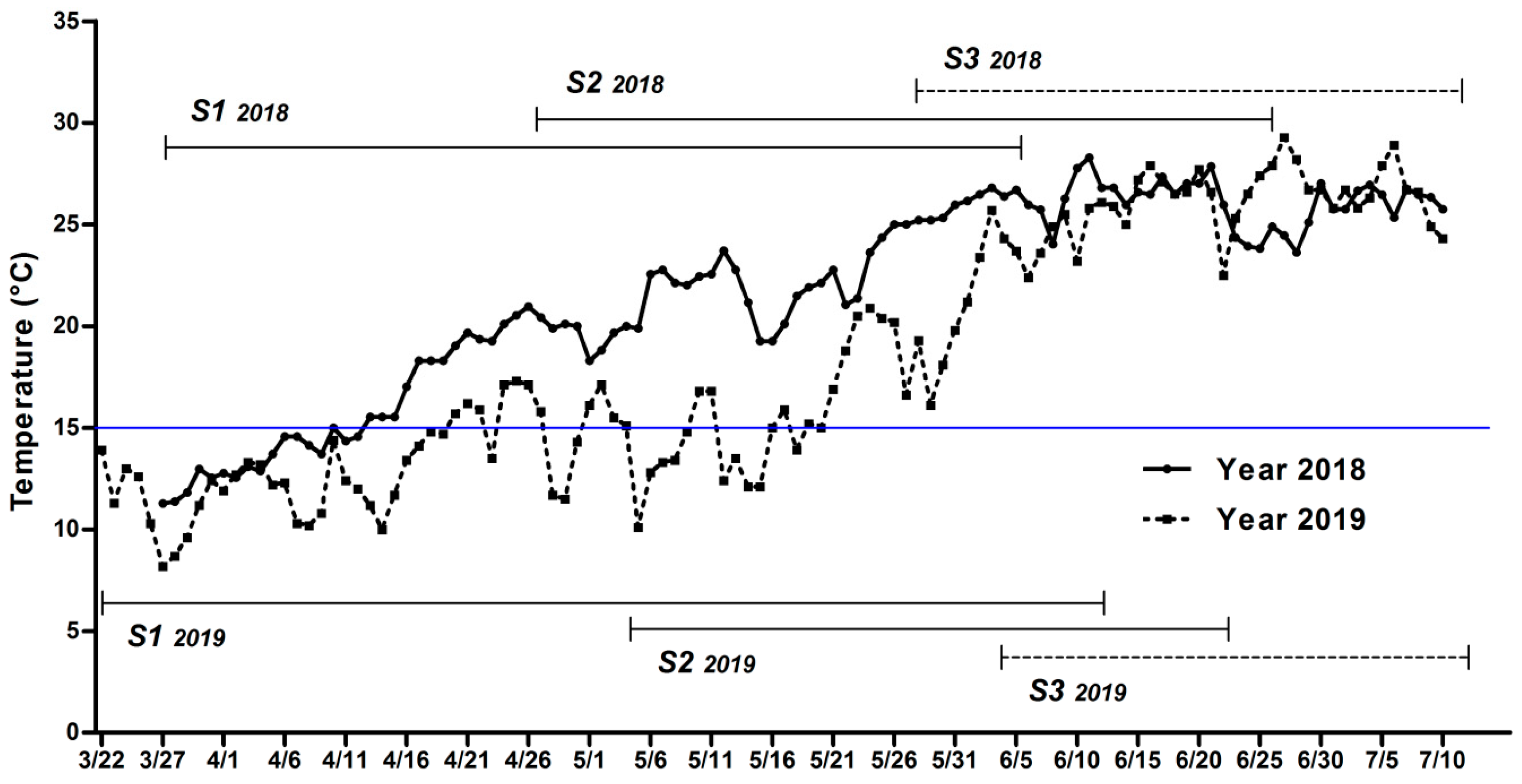
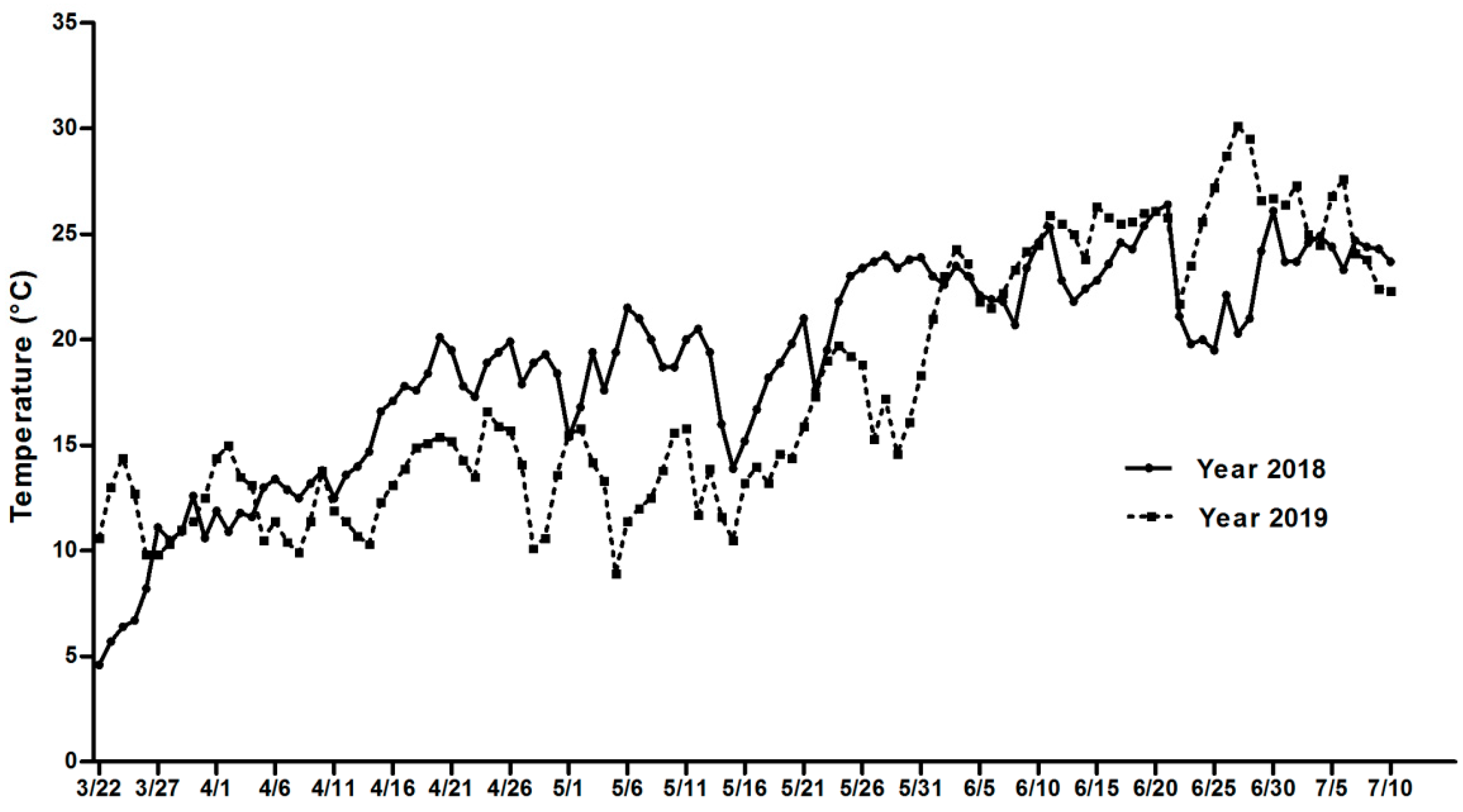
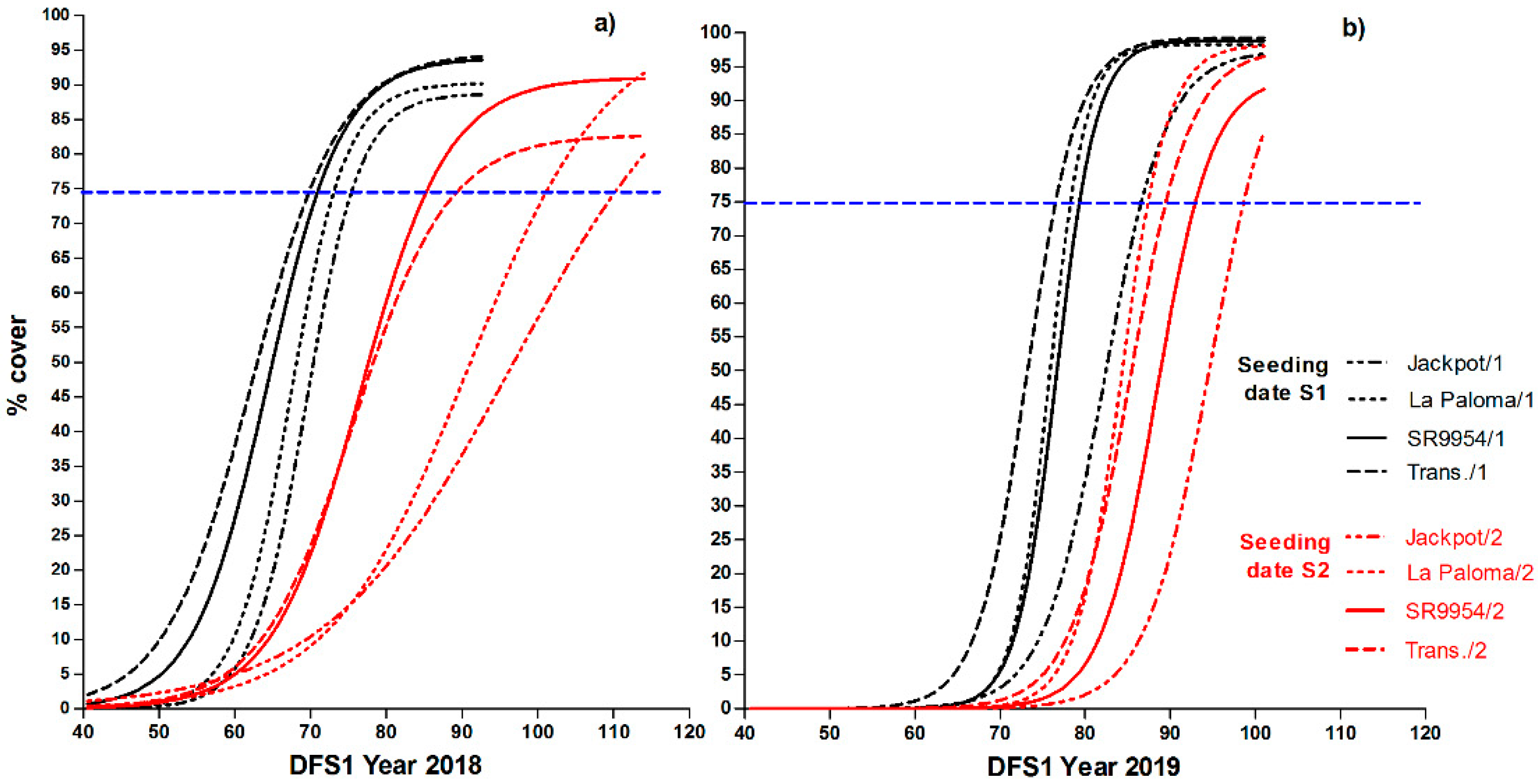
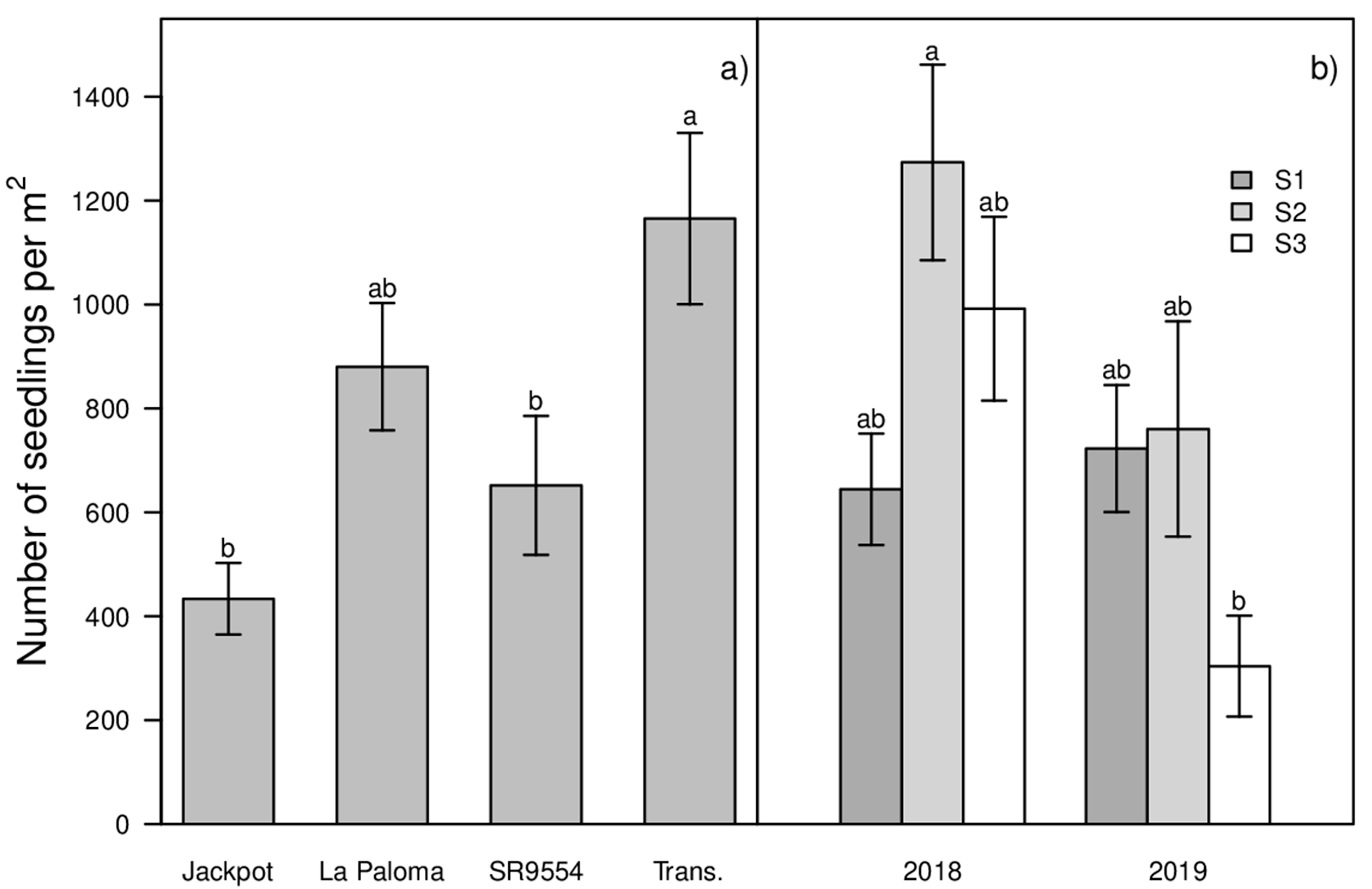
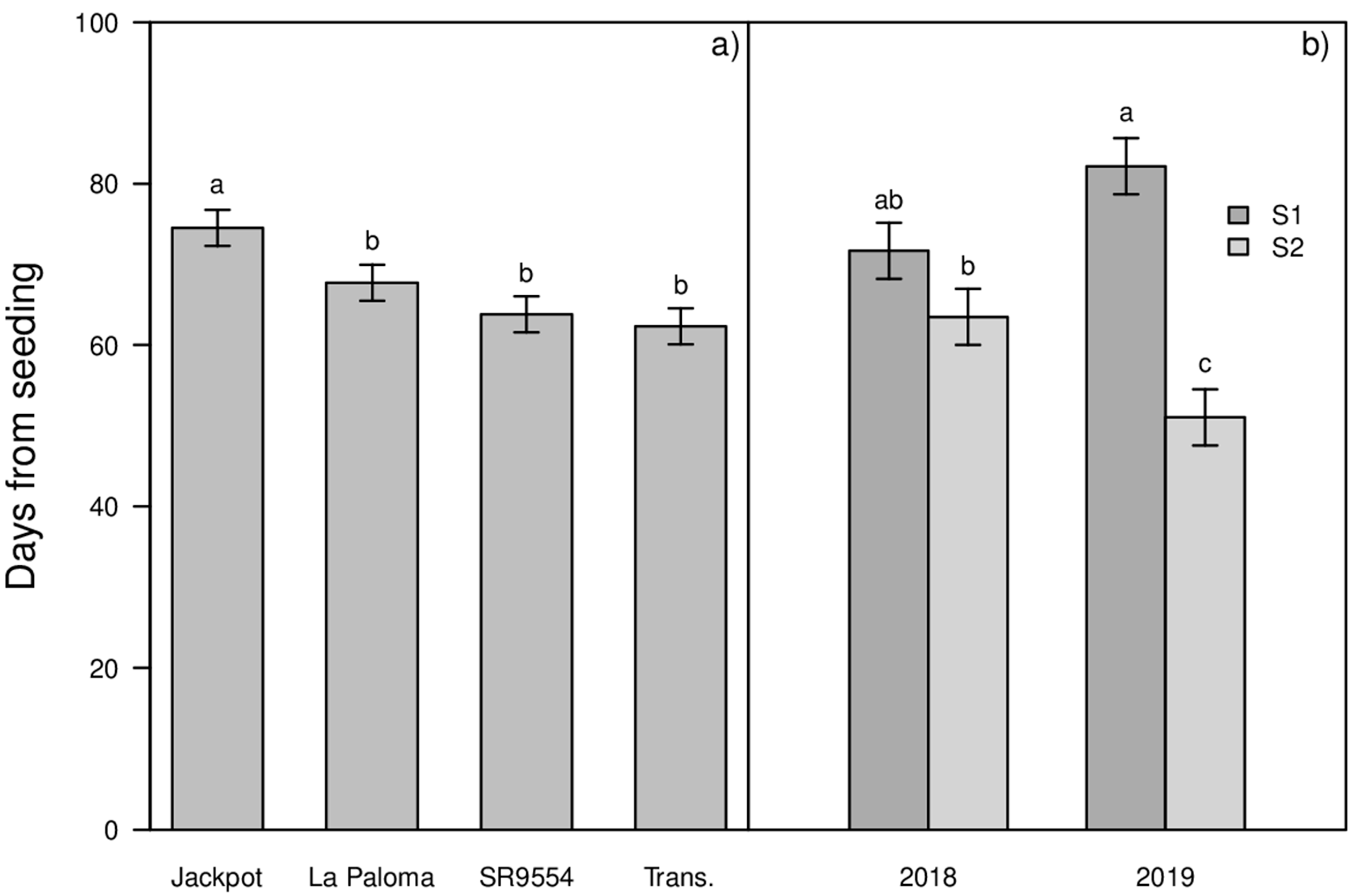
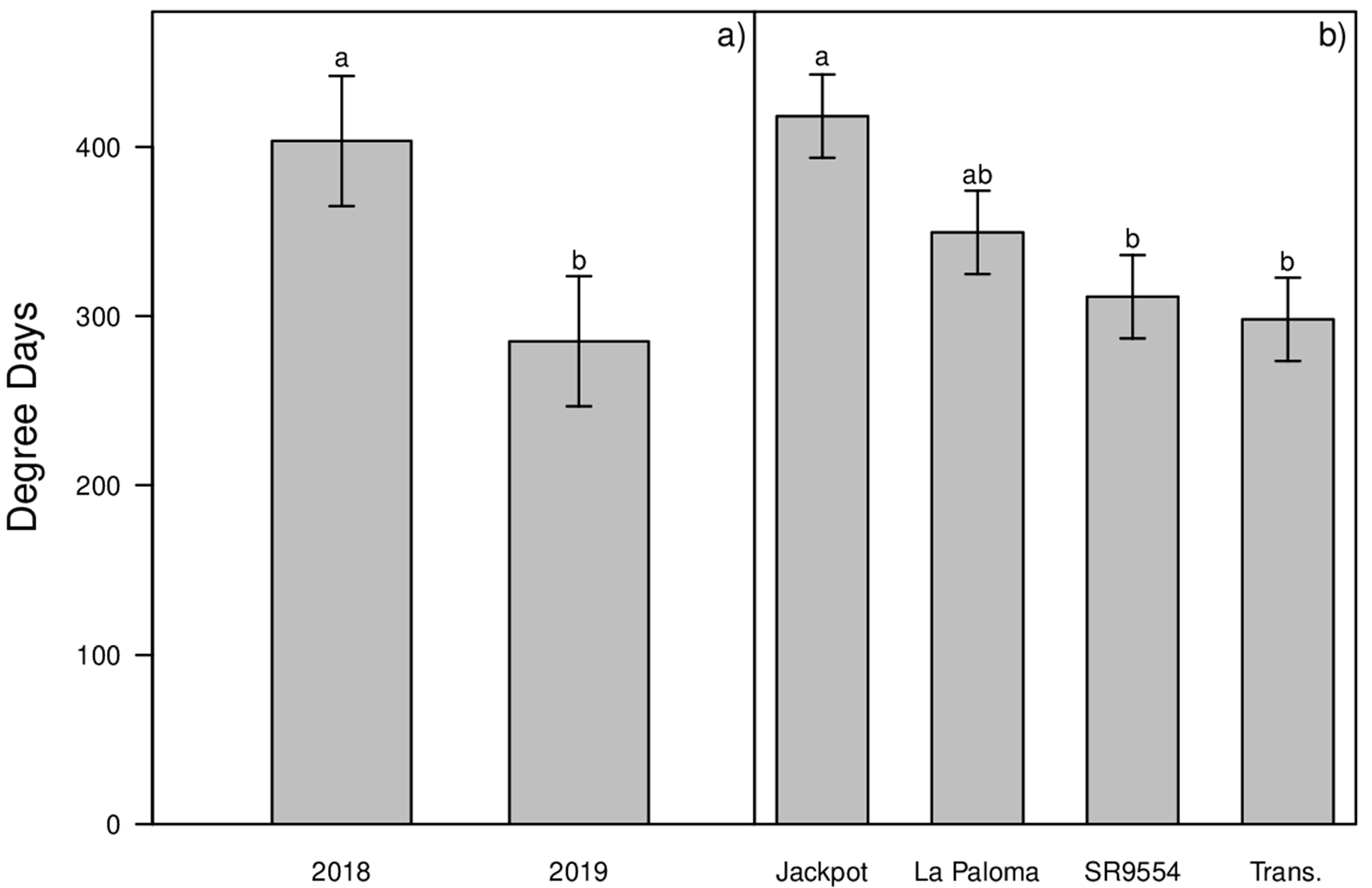
| Factors | DFSseed | Seedlings Nr | DFS1 | DFS | DD |
|---|---|---|---|---|---|
| Year | <0.001 | 0.019 | NS | NS | 0.037 |
| Seeding time | <0.001 | NS | 0.009 | 0.005 | NS |
| Cultivar | NS | <0.001 | <0.001 | <0.001 | <0.001 |
| Year × seeding time | NS | 0.009 | NS | 0.030 | NS |
| Year × cultivar | NS | NS | NS | NS | NS |
| Seeding time × cultivar | NS | NS | NS | NS | NS |
| Year × seeding time × cultivar | NS | NS | NS | NS | NS |
© 2020 by the authors. Licensee MDPI, Basel, Switzerland. This article is an open access article distributed under the terms and conditions of the Creative Commons Attribution (CC BY) license (http://creativecommons.org/licenses/by/4.0/).
Share and Cite
Giolo, M.; Pornaro, C.; Onofri, A.; Macolino, S. Seeding Time Affects Bermudagrass Establishment in the Transition Zone Environment. Agronomy 2020, 10, 1151. https://doi.org/10.3390/agronomy10081151
Giolo M, Pornaro C, Onofri A, Macolino S. Seeding Time Affects Bermudagrass Establishment in the Transition Zone Environment. Agronomy. 2020; 10(8):1151. https://doi.org/10.3390/agronomy10081151
Chicago/Turabian StyleGiolo, Maurizio, Cristina Pornaro, Andrea Onofri, and Stefano Macolino. 2020. "Seeding Time Affects Bermudagrass Establishment in the Transition Zone Environment" Agronomy 10, no. 8: 1151. https://doi.org/10.3390/agronomy10081151
APA StyleGiolo, M., Pornaro, C., Onofri, A., & Macolino, S. (2020). Seeding Time Affects Bermudagrass Establishment in the Transition Zone Environment. Agronomy, 10(8), 1151. https://doi.org/10.3390/agronomy10081151







